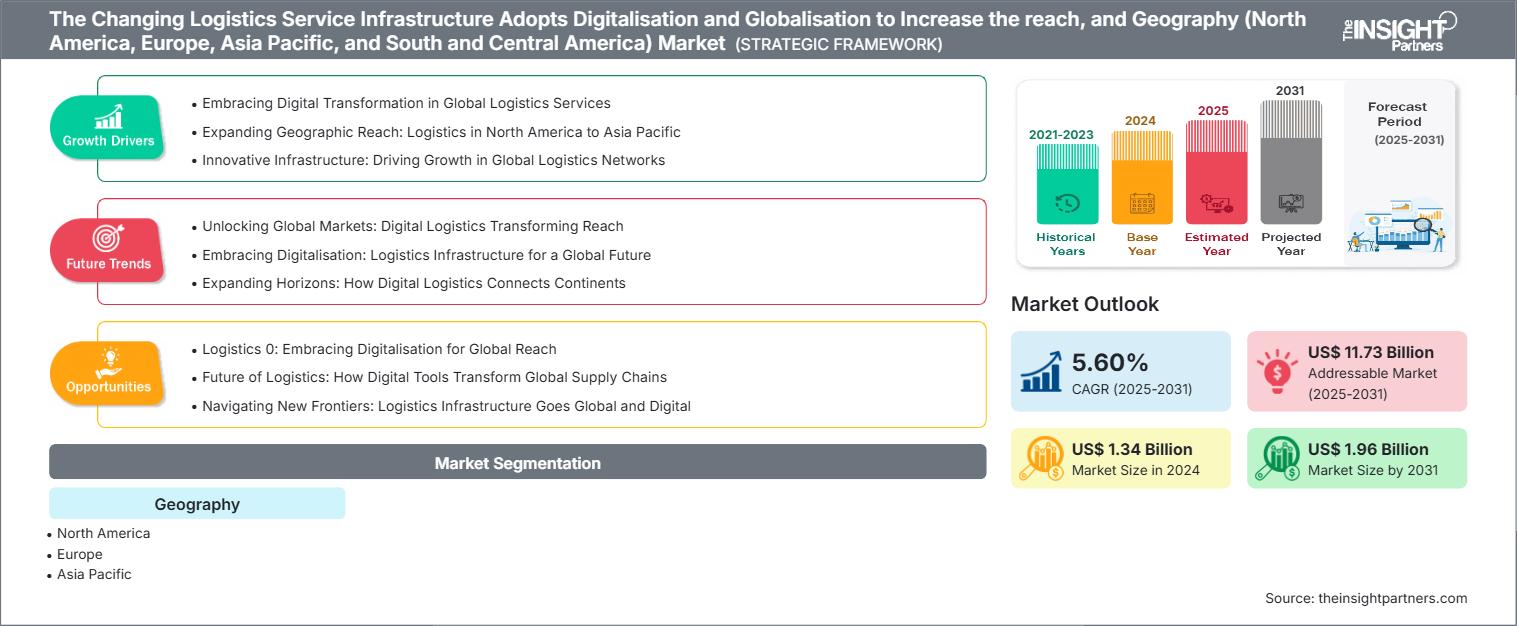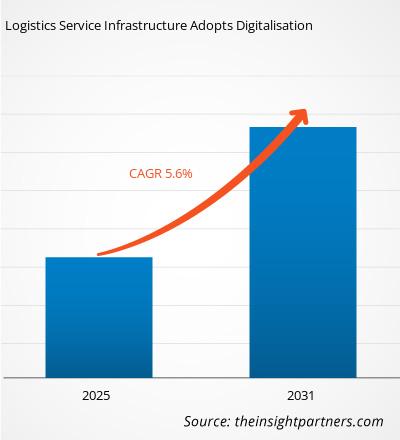物流サービス市場は、2021年の10億7,747万米ドルから2031年には1兆7,582.2億米ドルに達すると予測されており、2021年から2031年にかけて5.6%のCAGRで成長すると予想されています。
運用効率の向上への依存度の高まりと、運用コストの削減を目的とした物流業務および特定のサプライチェーンプロセスのアウトソーシングの人気の高まりは、さまざまな分野で勢いを増しています。さらに、サードパーティロジスティクスおよびフォースパーティロジスティクス企業の出現により、物流サービスプロバイダーに対する世界的な需要が高まっています。貨物輸送、貨物管理、コンサルティング、ルート最適化、ネットワーク分析、プロジェクト管理、在庫および保管管理、サプライチェーンコンサルティングは、大手物流企業が提供する主要なサービスです。また、リアルタイムの追跡と監視、分析、予測、計画など、技術主導の物流サービスの使用に関連する多様な利点は、市場参加者の収益性をさらに高めます。物流サービス業界は、さまざまな物流サービスに特化した複数の企業が存在し、大規模な顧客基盤が存在するため、非常に細分化されています。
アジアやアフリカといった新興経済国の国内企業は、安定した競争力のある物流サービス価格設定によって、市場競争をさらに激化させています。サプライチェーンネットワークは絶えず変化しており、新たな貿易回廊が開拓されています。これらの新たな貿易回廊を活用できる組織や経済圏は、世界貿易の進展から最大の利益を得る可能性が高いでしょう。こうした機会の一部は、先進国市場では広く活用されているものの、多くの発展途上国では導入が限定的、あるいは全く行われていない包括的なベストプラクティスの共有から生まれると期待されています。人材管理に関する戦略策定とコンサルティング、例えば管理会計システム、ダイバーシティマネジメント、知識共有、過去の自由化プロセスにおけるKPI、そして強力な企業の社会的責任(CSR)実践の構築などが挙げられます。継続的な投資、新製品開発、そして最新技術の統合により、世界の物流サービス業界は今後数年間で急速に拡大すると予想されています。物流サービス市場は、顧客に最高のサービスを提供するために継続的に研究開発に投資している、数少ない著名なグローバル企業によって支配されています。地理的発展と技術革新の面では、物流サービスプロバイダー、特にサードパーティサービスプロバイダーは驚異的な成長を遂げています。例えば、3PL組織は現在、業務において非効率性とコストを削減するために、様々なソフトウェアベースのソリューションを導入しています。さらに、倉庫管理システムの通信に音声認識ソフトウェアを導入することで、注文処理と在庫記録をサポートし、スタッフの配置やトレーニングの必要性を軽減しています。アジア太平洋地域は物流サービス市場の過半数を占めており、予測期間中は市場で最も高いCAGRを記録すると予測されています。
このレポートの一部、国レベルの分析、Excelデータパックなど、あらゆるレポートを無料でカスタマイズできます。また、スタートアップや大学向けのお得なオファーや割引もご利用いただけます。
変化する物流サービスインフラは、デジタル化とグローバル化を採用して範囲を拡大し、地域(北米、ヨーロッパ、アジア太平洋、南米、中米)市場:戦略的洞察

-
このレポートの主要な市場動向を入手してください。この無料サンプルには、市場動向から見積もりや予測に至るまでのデータ分析が含まれます。
COVID-19パンデミックによる物流サービス市場への影響
COVID-19の発生は、2021年後半から2021年にかけて世界経済に影響を及ぼし、フライトのキャンセル、渡航禁止、検疫措置などにより、世界中のサプライチェーンと物流活動全体が大幅に減速しました。商品の移動、保管、流れに関わる物流会社は、COVID-19パンデミックの影響を直接受けています。しかし、パンデミックに苦しんでいる業界がある一方で、ヘルスケアや医薬品など、他の業界は繁栄しています。電子商取引や日用品も、COVID-19が発生した場合、世界の物流業界にプラスの影響を与えるでしょう。さらに、病院用品、手袋、消毒剤、ワクチン、生鮮食品などの医療およびFMCG用品の需要の増加は、COVID-19パンデミックの中で物流市場の成長を牽引しています。
物流サービス市場:市場洞察:
リバースロジスティクス業務の増加による電子商取引業界の成長
電子商取引とは、インターネット上で商品を売買することを指します。物流サービスプロバイダーは、消費者に商品を配送するという通常の機能に加えて、電子商取引事業のサプライチェーンを管理・監視することで、電子商取引業界のニーズにも対応しています。これにより、これらの企業はマーケティングやその他の事業運営に集中できます。電子商取引業界に対する物流の利点は、世界中で物流サービスの受け入れを大幅に増加させました。2021年4月に発表された最新の国連貿易開発会議(UNCTAD)レポートによると、2021年の世界の電子商取引の売上高は25.6兆米ドルに達し、世界の国内総生産(GDP)の約30%を占めました。2021年、世界のB2B電子商取引事業の価値は21兆米ドルで、世界の電子商取引全体の約83%を占めました。さらに、B2C電子商取引の価値は4.4兆米ドルでした。この成長は、越境ショッピングの急増に起因しています。 2021年には14億人以上がオンラインで買い物をし、米国、中国、日本の企業が世界の電子商取引の売上を独占しています。
変化する物流サービスインフラは、デジタル化とグローバル化を採用して範囲を拡大し、地域(北米、ヨーロッパ、アジア太平洋、南米、中米)市場地域分析
変化する物流サービスインフラは、デジタル化とグローバル化を採用し、リーチを拡大しています。また、地域(北米、ヨーロッパ、アジア太平洋、中南米)市場に影響を与える地域的な傾向と要因は、The Insight Partnersのアナリストによって予測期間を通じて徹底的に説明されています。このセクションでは、変化する物流サービスインフラは、デジタル化とグローバル化を採用し、リーチを拡大しています。また、地域(北米、ヨーロッパ、アジア太平洋、中南米)市場セグメントと、北米、ヨーロッパ、アジア太平洋、中東・アフリカ、中南米の地域についても説明します。
変化する物流サービスインフラは、デジタル化とグローバル化を採用して範囲を拡大し、地域(北米、ヨーロッパ、アジア太平洋、南米、中米)市場レポートの範囲を拡大しています。
| レポート属性 | 詳細 |
|---|---|
| 2024年の市場規模 | 13億4000万米ドル |
| 2031年までの市場規模 | 19億6000万米ドル |
| 世界のCAGR(2025年~2031年) | 5.60% |
| 履歴データ | 2021-2023 |
| 予測期間 | 2025~2031年 |
| 対象地域と国 |
北米
|
| 市場リーダーと主要企業の概要 |
|
変化する物流サービスインフラは、デジタル化とグローバル化を採用して範囲を拡大し、地理的分布(北米、ヨーロッパ、アジア太平洋、南米、中南米)市場プレーヤーの密度:ビジネスダイナミクスへの影響を理解する
変化する物流サービスインフラは、デジタル化とグローバル化を採用し、リーチと地域(北米、ヨーロッパ、アジア太平洋、中南米)を拡大しています。市場は、消費者の嗜好の変化、技術の進歩、製品の利点に対する認識の高まりといった要因によるエンドユーザーの需要増加に牽引され、急速に成長しています。需要の増加に伴い、企業は提供内容を拡大し、消費者ニーズを満たすために革新を起こし、新たなトレンドを活用しており、これが市場の成長をさらに促進しています。

- 変化する物流サービスインフラはデジタル化とグローバル化を採用して範囲を拡大し、地域(北米、ヨーロッパ、アジア太平洋、南米、中米)市場の主要な主要プレーヤーの概要を入手してください。
輸送モードに基づく市場分析
効率的な輸送とは、比較的安全な方法、適切な時間、適切な状態、そして費用対効果の高い方法で商品を物理的に移動させることです。輸送は、商品を製造場所または保管場所から使用場所または流通場所、そして最終消費地まで移動させる役割を果たします。輸送手段に基づいて、物流サービス市場は道路、鉄道、水路、航空路に分類されます。輸送手段の選択基準は、輸送中の商品と輸送物の物理的特性によって定義されます。状況によっては、道路や鉄道の損壊などの環境要因が選択方法に大きな影響を与える可能性があります。
物流業者ベースの市場分析
世界の物流サービス市場は、コンポーネントタイプ別に、ファーストパーティロジスティクス、セカンドパーティロジスティクス、サードパーティロジスティクス、フォースパーティロジスティクス、フィフスパーティロジスティクスに分類されます。サードパーティロジスティクスプロバイダー(3PL)は、企業のサプライチェーン管理機能の一部、または場合によってはすべてを担う物流サービスを提供します。サードパーティのサプライチェーンマネージャーへの物流のアウトソーシングは、継続的なトレンドとなっています。物流サービス市場は現在、1,0774.6億米ドルと推定されており、物流サービスの大部分はサードパーティにアウトソーシングされています。ただし、アウトソーシングのレベルは国によって大きく異なります。一般的に、英国と米国ではアウトソーシングが好まれる物流活動ですが、中国とインドはサードパーティロジスティクス事業の将来の成長に大きな可能性を秘めています。
組織規模に基づく市場分析
物流サービスは、商品をある場所から別の場所へ輸送する事業にとって不可欠であり、そのプロセスに伴う煩雑さを回避するために、様々な中小企業から大企業が物流サービスを導入しています。急速な技術発展に伴い、多くの中小企業や大企業が物流サービスを選択しています。これにより、企業はコアコンピタンスへの注力、企業再編、コスト削減を実現しています。組織規模に基づいて、世界の物流サービス市場は中小企業と大企業に区分されています。
製品開発は、企業が製品ポートフォリオを拡大するために一般的に採用されている戦略です。FedEx、Maersk、DHL、UPS、Expeditorsといった主要企業は、物流サービス市場における顧客基盤と収益シェアの拡大を目指し、こうした戦略を実行しています。これにより、企業はブランドイメージを維持しています。最近の重要な動向をいくつかご紹介します。
- 2021年11月、コンテナ物流のグローバルインテグレーターであるAPモラー・マースクは、サウジアラビア港湾局と20万5000平方メートルの統合物流施設を建設するための正式契約を締結しました。この施設は、顧客に倉庫・配送、冷蔵倉庫、eコマースのための広範なインフラを提供します。また、この施設は、積み替え、石油化学製品の混載、航空貨物、コンテナ貨物のハブとしても機能します。
- 2021年1月、FedExとMicrosoftは、eコマース業界向けの新たなクロスプラットフォーム物流ソリューションを発表しました。この新サービスは、顧客エンゲージメントの向上と充実した配送オプションの提供を通じて、eコマース分野における加盟店の競争力向上を目指しています。
物流サービス市場は、輸送モード、物流プロバイダー、組織規模、およびエンドユーザーに基づいてセグメント化されています。輸送モードに基づいて、市場は道路、水路、鉄道、航空に分割されます。物流プロバイダーに基づいて、市場はファーストパーティロジスティクス、セカンドパーティロジスティクス、サードパーティロジスティクス、フォースパーティロジスティクス、フィフスパーティロジスティクスに二分されます。組織規模に基づいて、市場は中小企業と大企業に分割されます。エンドユーザーに基づいて、市場はさらに政府および公共事業、ヘルスケア、工業製造、小売および消費財、航空宇宙および防衛、その他に分割されます。
CEVA Logistics、Panalpina World Transport (Holding) Ltd.、United Parcel Service (UPS)、CH Robinson Worldwide, Inc.、AP MOLLER – MAERSK、日本通運、FedEx、DB Schenker、DHL International GmbH、KUEHNE + NAGEL は、世界の物流サービス市場で事業を展開している大手企業の一部です。
- 過去2年間の分析、基準年、CAGRによる予測(7年間)
- PEST分析とSWOT分析
- 市場規模価値/数量 - 世界、地域、国
- 業界と競争環境
- Excel データセット
最新レポート
お客様の声
購入理由
- 情報に基づいた意思決定
- 市場動向の理解
- 競合分析
- 顧客インサイト
- 市場予測
- リスク軽減
- 戦略計画
- 投資の正当性
- 新興市場の特定
- マーケティング戦略の強化
- 業務効率の向上
- 規制動向への対応






















 無料サンプルを入手 - 変化する物流サービスインフラは、デジタル化とグローバル化を採用して範囲と地理範囲を拡大しています(北米、ヨーロッパ、アジア太平洋、南米、中米)。
無料サンプルを入手 - 変化する物流サービスインフラは、デジタル化とグローバル化を採用して範囲と地理範囲を拡大しています(北米、ヨーロッパ、アジア太平洋、南米、中米)。